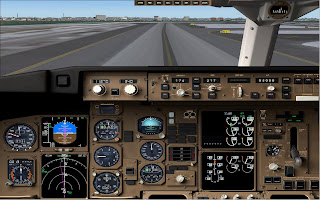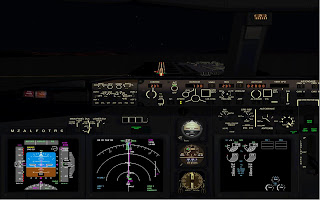Although I've flown pretty much all around the world, I had never done a flight across the pond or any flight longer than 3 hours for that matter. I wanted to change that and cross the Atlantic, try the capabilities of my beloved PSS 757.
I went for the Northwest 300 variant for this trip, the longer more "capable" one of the 757 series. That said, the 200 version also flies very often on flights across the Atlantic. I might as well go for the Delta 200 variant next time, maybe to Amsterdam but definitely easterly following the winds.
I took a brief look at flightaware before the flight to see if there was a real world NWA flight from Boston to Manchester but couldn't find any, oh well, that's fine plenty of numbers to pick from for a fictitious flight, one of the advantages of FS, only your imagination is the boundry.
Taxi checklist complete, where is that "Kilo"?

I don't like using the taxi aid so I try to use airport charts and taxi signs to find my way around, a good way is also to spot other AI heading out to the active, I just follow them if I'm totally lost.
The route of my 2775NM flight was:
PSM EBONY N95B CYMON DENDU 5150N 5240N 5330N 5520N RESNO BEL UL10 IOM MIRSI
Take-off weight was just below 238 000 lbs, way under the maximum of this variant. I loaded more fuel than calculated just in case as I wasn't familiar with the route and weather on this course. Block time was 6 hours and 32 minutes.
Taxing on "November" to runway 22R

The Logan4 departure instructs left heading 140 after take-off and then vectoring to fix, that's basically what I did, letting FS ATC vectoring me to the PSM VOR.
Load factors are usually high on my flights and this one was no exception, however, the 757 with it's stunning performance climbed steeply upto around FL 340 and continued to FL 380 more slowly. Actually, I made a mistake here, I should have set a lower cruise altitude for the initial phase of the flight and let the FMS go for a step climb, it would have been more realistic too. Next time, then...
I wonder if the passengers would decide to fly with me anyway if they knew I was crossing the ocean for the first time... I guess not but as most simmers know, your common FS passenger (not the add-on) is extremely brave, to the extent of being almost stupid!
The flight went perfectly anyway, nobody would have noticed. (Yeah, right!)
Weather at Boston was clear with winds 286/10, perfect for flying.
Ready to roll, 22R

No much to report on initial climb, no turbulence or anything, nice and smooth...
To add a note here, I might have mentioned this before, I love to use real world charts on my flights and specifically for a transatlantic one my good friend generously gave me a real world North Atlantic plotting chart which I found to be an extremely neat and useful tool for my trip over the ocean.
Logan Intl and the city of Boston on my left

On my flights, I like to look around on departure and arrival, not an easy task though, as it's the most busy part of the flight.
Heading to Europe

I heard plenty of the other usual "customers" over the ATC, Lufthansa, American, Speedbird, El Al, Virgin...etc coming and going from/to Europe.
Cruise flight was smooth at this stage until I made contact with Gander, then I encountered moderate turbulence, that annoying "juice spiller" if you see what I mean.
It got dark before I left Canada, not suprising as I was heading east.
My inflight IFE consisted mainly of improving my online rank on Call of Duty MW2 all the while taking a look if everthing was OK between matches, noting the remaining fuel at waypoints.
Leaving Canada

The flight over the Atlantic was pretty smooth, none of the turbulence I had over the East coast of Canada.
4 hours into trip I decided to have dinner (steak with fries) and after that I went over my arrival route while enjoying a cigar and an espresso. (Try that in a real cockpit)
I went for a Mirsi1C arrival following a landing on runway 23R. Weather at EGCC at that stage of the flight was winds 160/5 with 1500 meters visibility and broken clouds at 900. A quick look at the TAF revealed that the winds would shift in the southwesterly direction so indeed runway 23R looked like the right decision.
Over the Pond

As I entered Irish airspace, turbulence showed up again and continued all the way down during descent.
Flying over Belfast

I normally descend in VNAV mode but this time I decided to stick more to real life procedures and descended using V/S while keeping an eye on the VNAV indicator on the ND. The turbulence was giving VNAV a hard time anyway.
Mirsi1C arrival

You can notice the discontinuity after Mirsi on the ND, there is an ILS approach pattern for my arrival runway at EGCC but I simulated a "vectors to final" in HDG mode. I'm not aware of the procedures at Manchester but I suspect they do it this way too. Vectoring is quite common at large airports.
Final for 23R

If you've noticed, the runway on the ND is noted 24R as opposed to the real world 23R. This is because my airac cycle is an old one which doesn't cover the modification that took place a couple of years ago
Localizer intercept and final approach are undoubtably the most fun phases of any flight (IMHO) and once stabilized I go manual at around 1000 feet.
My landing was perfect, I must say, textbook stuff this time. Probably luck though...
Taxing to the gate at EGCC

Vacating the runway, I headed for my gate during which I did some spotting at EGCC.
I'm not sure I'm parked at the right place, I was the only foreign carrier

Where should I head to next, Europe, Middle East, Asia, America... Hard to pick a location let alone with which aircraft to fly with. So many options...
Thanks for viewing



